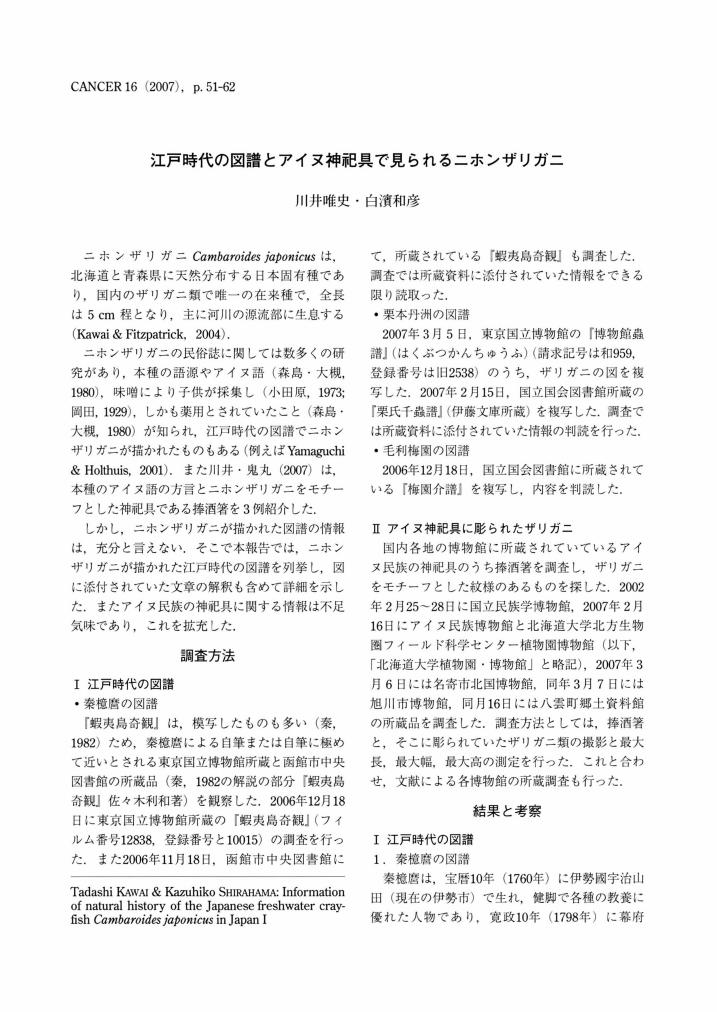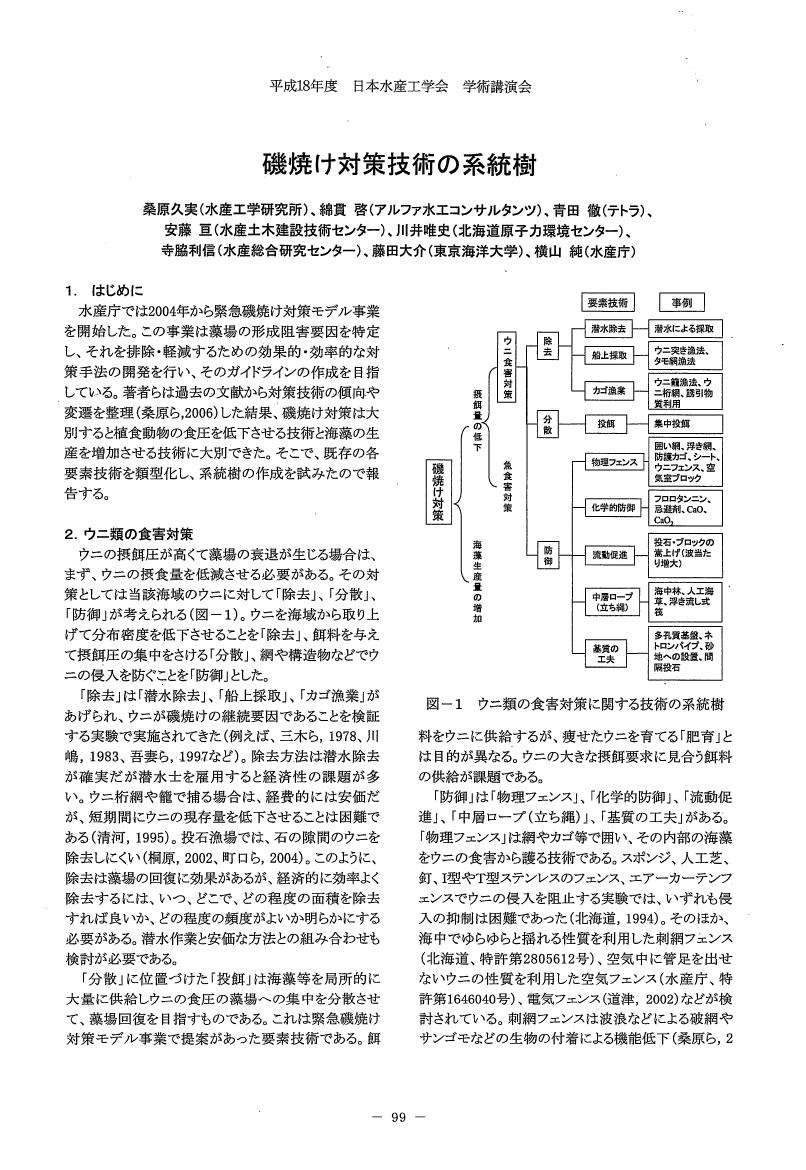- 著者
- Usio N 中田 和義 川井 唯史 北野 聡
- 出版者
- 日本陸水学会
- 雑誌
- 陸水学雑誌 (ISSN:00215104)
- 巻号頁・発行日
- vol.68, no.3, pp.471-482, 2007 (Released:2008-12-31)
- 参考文献数
- 56
- 被引用文献数
- 20 20
2006年2月1日,北米原産のシグナルザリガニPacifastacus leniusculus(ウチダザリガニ,タンカイザリガニ)が特定外来生物の第二次指定種に選定された。本報では,特定外来生物の将来的な管理計画を念頭に置き,シグナルザリガニの国内での分布と防除の現状を報告する。シグナルザリガニは,1926年から1930年にかけて北米のコロンビア川流域から輸入された後,北海道や本州の天然水域に移植され,近年,急速に北海道はもとより本州でも分布を拡大している。2007年7月現在,シグナルザリガニは,北海道の東部,北部および中央部の地域,そして本州の3県(福島県,長野県,滋賀県)に分布している。外来生物法の施行以降,これまで北海道でのみシグナルザリガニの防除が行われ,2006年度には4湖沼,2007年度には河川を含む4水域においてカゴ罠やSCUBA器具を用いた素手による防除が実施されている。一方,滋賀県今津町では,個体群独自の標準和名(タンカイザリガニ)を重んじてシグナルザリガニを保護しようとする動きがある。最後に,シグナルザリガニ防除の問題点や今後の課題について議論する。
8 0 0 0 OA ニホンザリガニの名称および長野県におけるウチダザリガニの現状
- 著者
- 川井 唯史 大高 明史
- 出版者
- 弘前大学教育学部
- 雑誌
- 弘前大学教育学部紀要 (ISSN:04391713)
- 巻号頁・発行日
- no.101, pp.31-40, 2009-03-30
The known distributional range of the Japanese crayfish, Cambaroides japonicus( De Haan, 1841()Crustacea,Decapoda, Cambaridae) is restricted to north part of Japan including Hokkaido, Aomori and northern parts of Akitaand Iwate Prefectures. Recently a new population of this species was discovered from natural habitat in Tamozawa,Nikko, Tochigi Prefecture, Centaral Honshu, Japan. Present study examined origin of the Nikko population based on thecomposition of symbiotic crayfish worms( Annelida, Clitellata, Branchiobdellida) as well as the crayfish morphologies(rostrum, telson and annulus ventralis). Three species of crayfish worms, Cirrdrilus cirratus Pierantni, 1905, C. inukaii(Yamaguchi, 1934), and C. ezensis( Yamaguchi, 1934) were detected from the Nikko crayfishes, all of which are knownto endemic to Hokkaido. Morphological characteristics in the crayfishe corresponded to those in Hokkaido population. Some documents and old archives (ca. 1900) in the Archivs and Mausolea Department, Imperial HouseholdAgency, Japan suggest that many individuals of C. japonicus had been transported to the Nikko Tamozawa Imperial Villafrom Hokkaido, and they were used as foods for the royal family. A map in an old archive indicates that there was anaquarium near the kitchen of the Imperial Villa. Consequently, it is highly probable that the present Nikko population ofC. japonicus is derived from introduced individuals for foods from Hokkaido.
8 0 0 0 OA ニホンザリガニの博物学的知見VIII―江戸時代の浮世絵に描かれたニホンザリガニ―
6 0 0 0 OA 摩周湖に分布するザリガニについて
- 著者
- 浜野 龍夫 林 健一 川井 唯史 林 浩之
- 出版者
- 一般社団法人 日本甲殻類学会
- 雑誌
- 甲殻類の研究 (ISSN:24330108)
- 巻号頁・発行日
- vol.21, pp.73-87, 1992-12-31 (Released:2017-09-08)
- 被引用文献数
- 6 5
Crayfish in Lake Mashu, Hokkaido, Japan, were captured with tangle nets in the summer of 1992. All specimens, 171 males and 517 females, had intermediate diagnostic character between two subspecies, Pacifastacus leniusculus leniusculus and P, l. trowbridgii. Although three very large individuals of unidentified crayfish were captured in this lake by poachers of trout in 1975 and 1985, there is no certain confirmation because of illegal samplings. One of the present authors took a chance to measure one of them, a fresh male crayfish with very large chelae, in 1975 when he was 11 years old and recorded only its giant size, i.e. 47 cm carapace length. However, the largest P. leniusculus collected in this study was 5.7cm in c. l. Neoteny may have occurred because there is no secondary sexual character on chelae of adult P. leniusculus males. This lake has no river. Age of the lake is estimated as about 2000 years old. Further, all species of fish and crustaceans in the lake were artificially introduced from other waters. Of crayfish, only P. leniusculus occurs and was introduced from Portland, Oregon, U.S.A., in 1930. From these, the unidentified gigantic crayfish seems to have been P. leniusculus grown to a giant size.
2 0 0 0 OA 江戸時代の図譜とアイヌ神祀具で見られるニホンザリガニ
2 0 0 0 OA 「大正天皇のニホンザリガニ」についての新知見
2 0 0 0 OA 長野県安曇野市に生息する特定外来生物ウチダザリガニの生息地の環境とその由来
- 著者
- 熊川 真二 中田 和義 川井 唯史
- 出版者
- 日本ベントス学会
- 雑誌
- 日本ベントス学会誌 (ISSN:1345112X)
- 巻号頁・発行日
- vol.66, no.1, pp.26-32, 2011-10-15 (Released:2012-10-11)
- 参考文献数
- 20
- 被引用文献数
- 1 1
Official documents and archives suggest that the alien crayfish Pacifastacus leniusculus (Dana, 1852) was introduced into Japan from North America on five occasions from 1926 to 1930, and populations have survived in Hokkaido, Nagano, and Shiga Prefectures. The chemical conditions and biological environment of an established habitat near their original a release point in Akashina, Azumino City, Nagano Prefecture, were surveyed on four occasions in 1998 and 1999. Water quality (pH, DO, BOD) and WT were recorded seasonally at each of eight stations, and crayfish and other aquatic macro-organisms were collected. Some predatory fishes (Oncorhynchus mykiss, Anguilla japonica, and Lepomis macrochirus) that might actively eat juveniles of P. leniusculus were recorded. Individual density of P. leniusculus was relatively low compared to its other habitats in Japan. Only 52 crayfish were collected during this study, on 19 of 32 sampling occasions (eight sites, four times each). The shape of the acumen and the species composition of ectosymbiotic crayfish worms (Annelida: Clitellata: Branchiobdellidae) can be used as tools to trace the origin of introduced of P. leniusculus in Japan. The present crayfish from Nagano Prefecture have a relatively short acumen, different from those of specimens from Shiga and Hokkaido Prefectures. Furthermore, the crayfish worm Xironogiton victoriensis occurs only on crayfish from Akashina, Nagano Prefecture. The dates of introduction of P. leniusculus in Nagano (1926, 1929) also differ from those for Hokkaido (1930) and Shiga Prefecture (1926). These findings suggest that the regional population of P. leniusculus in Nagano has a different origin than those in Shiga and Hokkaido, having originated from crayfish that were introduced independently from North America.
2 0 0 0 OA ニホンザリガニの博物学的知見VII : 江戸後期から昭和初期の史料から得られた情報
- 著者
- 田中 一典 川井 唯史
- 出版者
- 日本甲殻類学会
- 雑誌
- Cancer : 会員連絡誌 (ISSN:09181989)
- 巻号頁・発行日
- no.24, pp.29-37, 2015-08-01
- 著者
- Usio N. 中田 和義 川井 唯史 北野 聡
- 出版者
- 日本陸水学会
- 雑誌
- 陸水學雜誌 = JAPANESE JOURNAL OF LIMNOLOGY (ISSN:00215104)
- 巻号頁・発行日
- vol.68, no.3, pp.471-482, 2007-12-20
- 被引用文献数
- 12
2 0 0 0 OA 摩周湖に分布するザリガニについて
- 著者
- 浜野 龍夫 林 健一 川井 唯史 林 浩之
- 出版者
- 日本甲殻類学会
- 雑誌
- 甲殻類の研究 (ISSN:02873478)
- 巻号頁・発行日
- no.21, pp.73-87, 1992-12-31
- 被引用文献数
- 4
Crayfish in Lake Mashu, Hokkaido, Japan, were captured with tangle nets in the summer of 1992. All specimens, 171 males and 517 females, had intermediate diagnostic character between two subspecies, Pacifastacus leniusculus leniusculus and P, l. trowbridgii. Although three very large individuals of unidentified crayfish were captured in this lake by poachers of trout in 1975 and 1985, there is no certain confirmation because of illegal samplings. One of the present authors took a chance to measure one of them, a fresh male crayfish with very large chelae, in 1975 when he was 11 years old and recorded only its giant size, i.e. 47 cm carapace length. However, the largest P. leniusculus collected in this study was 5.7cm in c. l. Neoteny may have occurred because there is no secondary sexual character on chelae of adult P. leniusculus males. This lake has no river. Age of the lake is estimated as about 2000 years old. Further, all species of fish and crustaceans in the lake were artificially introduced from other waters. Of crayfish, only P. leniusculus occurs and was introduced from Portland, Oregon, U.S.A., in 1930. From these, the unidentified gigantic crayfish seems to have been P. leniusculus grown to a giant size.
1 0 0 0 OA 磯焼け対策技術の系統樹
1 0 0 0 OA 文献から見た磯焼け対策研究の歩み
- 著者
- 桑原 久実 綿貫 啓 青田 徹 安藤 亘 川井 唯史 寺脇 利信 横山 純 藤田 大介
- 出版者
- 日本水産工学会
- 雑誌
- 日本水産工学会誌 (ISSN:09167617)
- 巻号頁・発行日
- vol.43, no.1, pp.81-87, 2006-07-15 (Released:2017-09-01)
- 参考文献数
- 21
- 被引用文献数
- 3
To detect the trend on seaweed restoration techniques on barren grounds in Japan, domestic literature (> 1,000) published since 1970 were surveyed. The literature contains local survey (18%), experiments and detailed observations (23%), recovery trials (43%) and reviews (16%). The literature increased chronologically with a temporal maximum in 1980-85. Among the local areas, literature was particularly abundant in western coasts of Hokkaido and Pacific coasts of middle Honshu (from the Kii Channel to Cape Inubo). The target seaweed bed types were mostly kelp and Sargassum forests and the dominant causative agents of these bed reductions were intensive grazing by sea urchins and herbivorous fishes. The literature analysis revealed that 'removal' of sea urchins and 'defense' of seaweeds were unreasonably preceded by employing stones or concrete blocks and transplanting seaweeds. Grazing by herbivorous fishes is a recent problem in southern Japan; the literature abruptly increases after 2000. These may represent some of the reasons why barren ground recovery projects were unsuccessful.
1 0 0 0 OA 室内水槽におけるニホンザリガニの卵発生に伴う卵色の変化
1 0 0 0 外来種ウチダザリガニの移入とニホンザリガニの国内送付に関する情報
- 著者
- 川井 唯史 中島 歩
- 出版者
- 日本甲殻類学会
- 雑誌
- Cancer : 会員連絡誌 (ISSN:09181989)
- 巻号頁・発行日
- no.14, pp.23-33, 2005-05-01
- 参考文献数
- 12
- 被引用文献数
- 2






